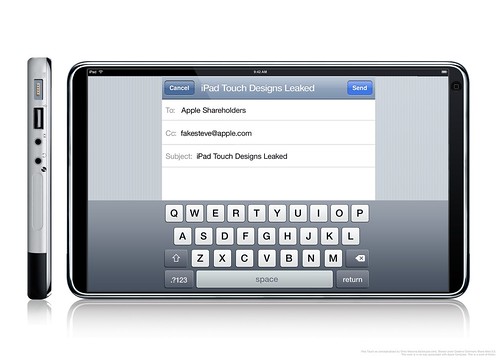- Computer screens are small. It's hard to see what you're doing, and when you have multiple players, not everybody can get a good look.
- It's hard to have hidden information unless you make people look away or take turns.
- Some of the fun in playing boardgames is moving the little bits around, holding cards, and rolling dice.
So, will the iPad work? Maybe. For problem #1 above, display size and visibility, the iPad has a big enough screen that you can show more of the board, and the fullscreen touchscreen will make for some neat interaction/interface possibilities. The fact you can zoom or slide easily will probably help too. I think really great computer-assisted boardgaming will probably require a larger thing like the iPad, something like the touchscreen tabletop here.
For problem #2, the problem of hidden information, some of the designs I've seen have people using iPhones or iTouches to store their hidden information while the community info is on the iPad. Pretty neat, and this allows for games with lots of hidden info to work face to face. But by the time you've bought an iPad for $500 and four iPhones or iTouches for a couple hundred each, you're investing a thousand bucks to play a tiny little boardgame. I think dedicated games that run on TVs (like this one) will be more economical (but maybe less neat-o) for this kind of thing for the next few years at least.
For problem #3, the hindrance factor of the interface, that's a tough call. If the games designed for the iPad are just rehashes of traditional boardgames, then you're not really gaining anything by playing them on the iPad, and you lose something. My first version of computer Monopoly back in 1985 used ASCII art and colored text to show the board. I worked really hard to get the whole game included, with trades, the Chance and Community Chest cards and their effects, and a bunch of other features. And in the end, it was deathly dull. You hit the space bar to roll, and your little character moved around the board with little bleeping noises, and stuff happened that you only rarely had control over. Other than the trades, which are rare, the only decisions were whether to buy or not, when to buy houses, and whether to pay to get out of jail or not. That's something that a well-designed iPad game could get around, but you'll probably have to start with something suited to the platform rather than just porting a real-life game to it.
So, the iPad is neat, and there is certainly potential for it to be a cool boardgame platform, but I don't think we've quite reached the face-to-face electronic boardgame experience everybody is hoping for. The closest I've come recently is places like SpielByWeb.com, where most of the solution is the Internet. You get to look at your own screen, your info stays hidden, and the game is fun. The only part that's lacking is the face-to-face experience of a real game night. It may be hard to get all of those ingredients together.
















The ideal would be a "microsoft surface" type
ReplyDeletetabletop, plus each player having a personal ipad for hidden information. As has been noted on BGG, there's nothing quite like using $10,000 of technology to replace a $50 board game.